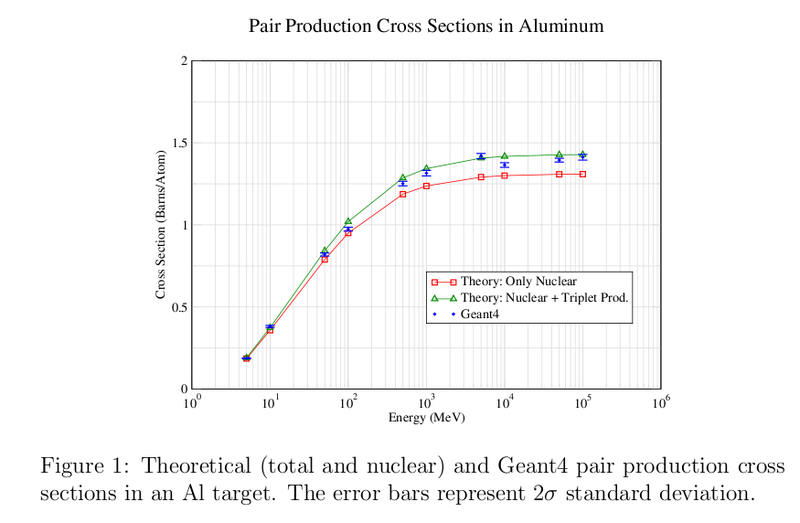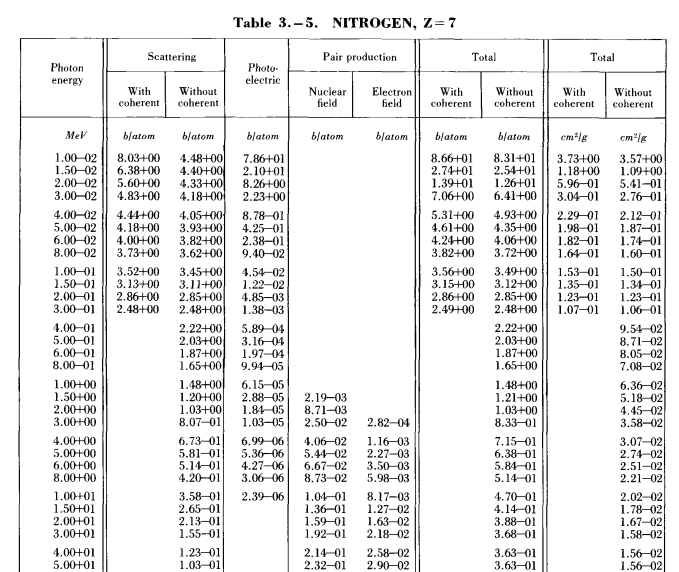Go Back
LINAC parameters used in calculations
1) pulse width 50 ps
2) pulse current 50 A
3) repetition rate 300 Hz
4) energy 44 MeV
Number of electrons/sec on radiator
[math] 50\ \frac{C}{sec} \times \frac{1\cdot e^-}{1.6\cdot 10^{-19}\ C} \times 50\ \mbox{ps} \times 300\ \mbox{Hz} = 0.47 \cdot 10^{13}\ \frac{e^-}{sec}[/math]
Number of photons/sec out of radiator
- [math]\sigma_{brems}=0.1\ \mbox{photons/electrons/MeV/r.l}[/math]
- [math]\mbox{r.l.(Ti)} = 3.59\ \mbox{cm}[/math]
- [math]\mbox{radiator}\ \mbox{thickness} = 12.5\ \mu m[/math]
[math]\frac{12.5\ \mu m}{3.59\ cm} = 3.48 \cdot 10^{-4}\ r.l.[/math]
[math]0.47 \cdot 10^{13} \frac{e^-}{sec} \times 0.1\ \frac{\gamma 's}{(e^- \cdot MeV \cdot r.l.)} \times 3.48 \cdot 10^{-4}\ r.l. \times 10\ MeV =1.63 \cdot 10^{9} \frac{\gamma}{sec}[/math]
Alex factor is 6.85 %
[math]1.63 \cdot 10^{9} \frac{\gamma}{sec} \cdot 6.85\ % = 1.12 \cdot 10^{8} \frac{\gamma}{sec}[/math]
Pair production rate
out of Al converter
[math]\sigma_{pairs} = 0.5\ \frac{barns}{atom}[/math]
[math]l = 3.0\ \mu m[/math] (by varying width we can vary the yield)
[math]N_{Al} = \frac{2.375\ \frac{g}{cm^3} \times 6.02 \cdot 10^{23}\ \frac{atoms}{mol} \times 3.0\ \mu m} {26.98\ \frac{g}{mol}} = 1.59 \cdot 10^{23}\ \frac{atoms}{m^2}[/math]
[math]\frac {1.12 \cdot 10^{8} \frac{\gamma}{sec} \times \sigma_{pairs} \times N_{Al}} {f} = 2.96\ \frac{pairs}{pulse} [/math]
through 1 m of air
[math]\sigma_{pairs} = 0.2\ \frac{barns}{atom}[/math]
[math]l = 1.0\ \mbox{m}[/math]
[math]N_{N} = \frac{0.00125\ \frac{g}{cm^3} \times 6.02 \cdot 10^{23}\ \frac{atoms}{mol} \times 1.0\ \mbox{m}} {14.01\ \frac{g}{mol}} = 5.37 \cdot 10^{25}\ \frac{atoms}{m^2}[/math]
[math]\frac {1.12 \cdot 10^{8} \frac{\gamma}{sec} \times \sigma_{pairs} \times N_{Al}} {f} = 2.96\ \frac{pairs}{pulse} [/math]
Appendix
pair production cross sections in an Al target
Ref. Geant4 and Theoretical Pair Production Cross Sections for 1 MeV - 100 GeV photons in Aluminum. Vakho Makarashvili, December 18, 2007

pair production cross sections in N
Ref. Photon Cross Section, Attenuation Coefficients, and Energy Absorption Coefficients From 10 keV to 100 Gev. J.H.Hubbell. Center for Radiation Research.National Bureau of Standards. Washington, D.C. 20234

Go Back

